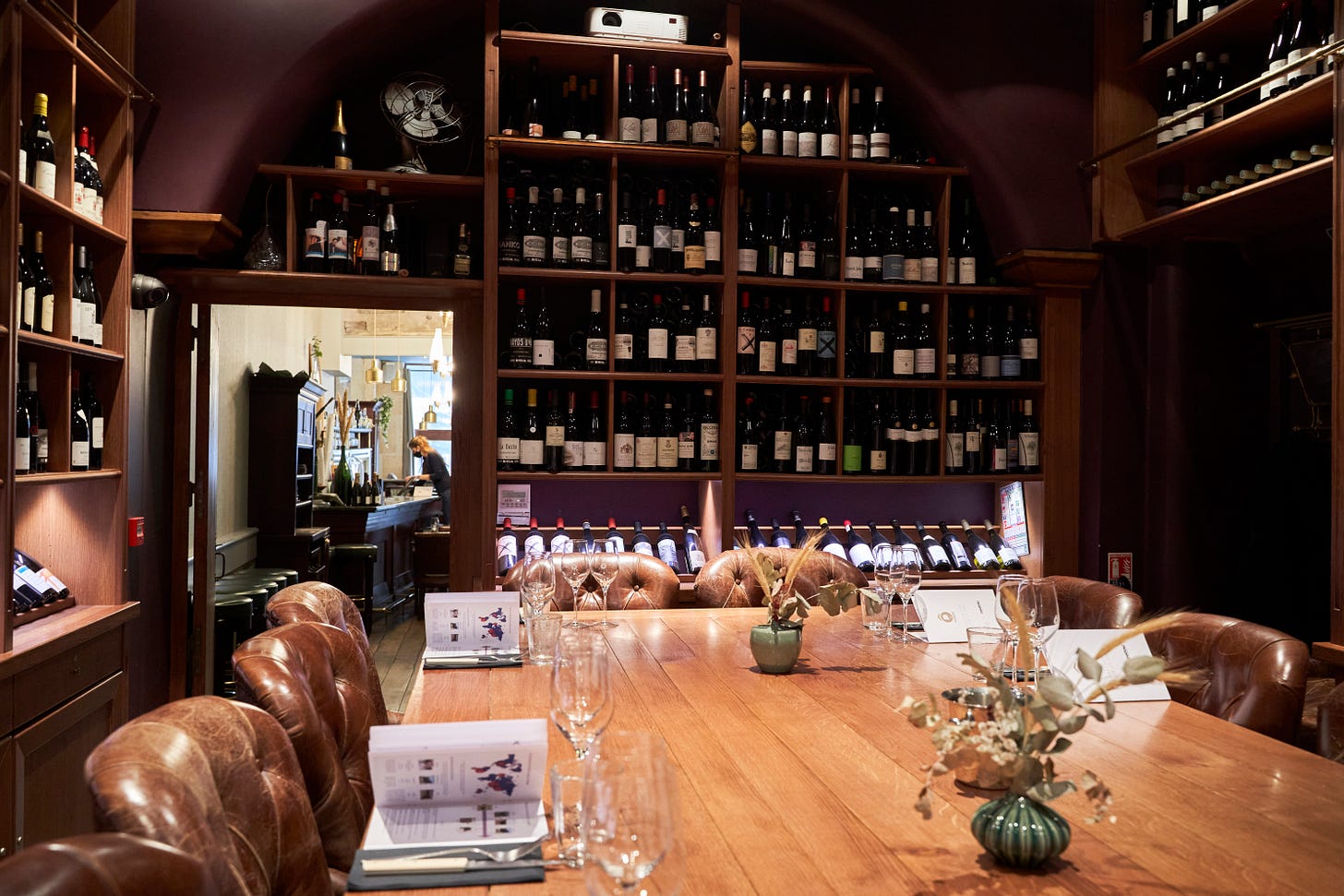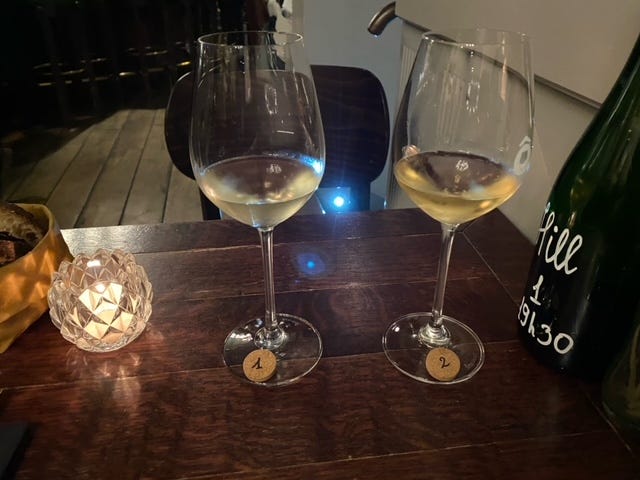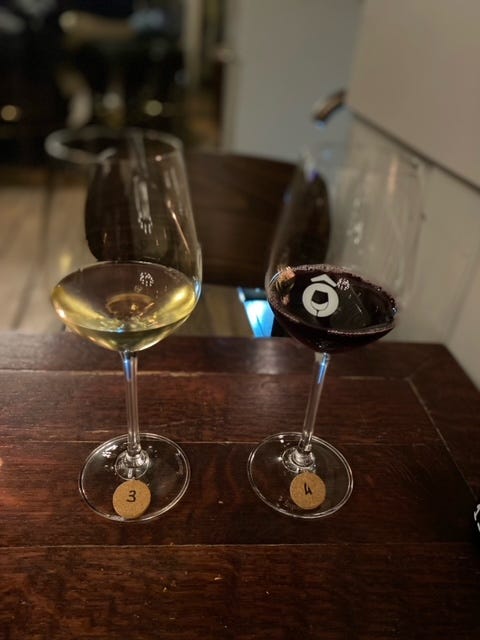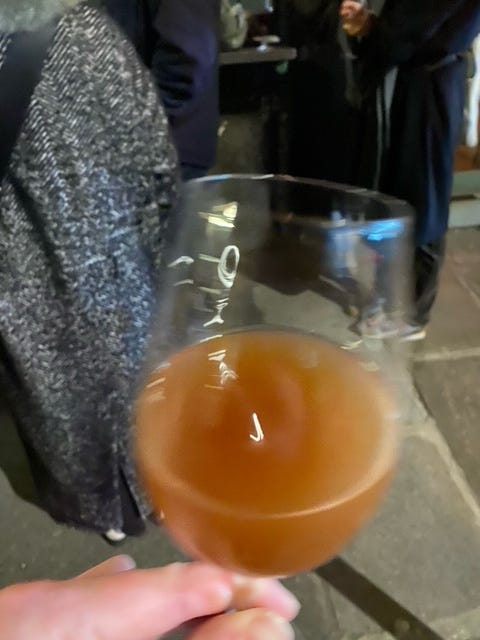O Chateau is one of my go-to places when I’m in Paris. Located on Rue Jean-Jacques Rousseau, a stone throw from the vast Les Halles shopping centre, this bar and restaurant has more than 50 wines by the glass and more than a 1,000 by the bottle – 80 per cent of which are organic, biodynamic or vegan. For a wine geek this is one of the closest you’ll come to finding heaven on earth, and what’s more, they’re more than happy to put on blind tastings.
The latter service may not be a key selling point for everybody, but I’m one of those strange people who love having a glass of something put in front of them ‘blind’ and asked to decipher what it is. This is one of the essential skills needed to pass the WSET Diploma, and it was tough. There were many ups and downs along the way and plenty of stories to tell as a result, but those will have to wait for another day.
The energetic Laury Rzepka is head sommelier at O Chateau – you may know her as extra_brut_ on Instagram – and she poured six wines of 100ml each, divided into three separate flights, so I wasn’t overwhelmed by having all six at once – although this is what you get in the final D3 Diploma tasting exams. In that you get six wines in the first exam, the first three from the same grape variety, which you are asked to identify, the second three from the same country. You then have a break of about an hour before the second exam, which consists of three wines all from the same region followed by a mixed bag. You then go to the pub and get drunk.
Things were far more chilled at O Chateau, and I was keen to test myself on what Laury – who is studying to be a master of wine – poured for me. So here goes. I didn’t jot everything down in Diploma style, so these notes may be slightly brief, but you’ll get the gist.
Flight One
Two white wines. Wine A was paler in appearance than Wine B, medium-plus intensity on the nose with a fair bit of stone and tropical fruit. There was evidence of secondary winemaking1 with brioche, leesy notes and what I thought was a touch of oak influence. Body was medium-plus with medium-plus finish. I guessed a chardonnay from Macon, perhaps Pouilly Fuisse2, from south Burgundy.
Wine B was pronounced in intensity with very strong aromas of aniseed – something I’ve hardly ever come across before in a white wine. On the palate it was medium-plus in body with a fair bit of phenolic grip3. I was totally stumped.
Flight Two
(I wasn’t spitting, so judgement was probably affected slightly by the wine drank in flight one)
Wine A was another white. It was medium-plus intensity. I was getting a fair bit of honeysuckle and well-defined citrusy fruit. I didn’t think I detected any prominent secondary winemaking. Acidity was high on the palate and there was good texture. A very good wine. I guessed a Riesling from Alsace.
Wine B was a red – medium ruby. Medium-plus intensity again with red fruit – in particular red berries. There was also evidence of floral, perfumey aromas. It was also a bit funky – I thought I was detecting some barnyard aromas so thought about Brettanomyces4. Medium body on the palate with medium tannin. I guessed a Beaujolais from one of the ‘cru’ regions, perhaps Moulin-au-Vent or Morgon.
Flight Three
(By now I had drunk all of flights one and two. There was no way I was spitting – I was on holiday)
Wine A was deep ruby and I was getting a lot of black fruit, in particular black berry and blackcurrant. There was also herbaceous notes but the wine wasn’t underripe – in fact it was quite dense. There were also traces of cedar. On the palate it was full-bodied and I thought it was a bit of a blunt instrument that lacked complexity. That said, there was good definition of fruit and a very good wine. I was pretty sure cabernet sauvignon was the main variety – and perhaps it came from Bordeaux but I wasn’t 100 per cent sure of this.
Wine B was one of my favourites of the evening. I thought the palate was pronounced, with well-defined red fruit, perfume aromas and spicy with some age. On the palate the tannins were medium-plus and smooth and there was complexity from age and secondary winemaking and I marked it as outstanding. I was finding it tricky where to locate this in France so I went for Chateauneuf-du-Pape, because of what I thought was high quantity of grenache in the blend.
The results
Laury revealed the wines after each flight, so my confidence was pretty shot by the final flight, but I still really enjoyed the exercise and it was great chatting to Laury.
Flight One
Wine A was in fact a 2022 Sancerre – ‘Grand Chaille’ from Domaine Thomas & Fils. This shocked me as I wasn’t getting any of the grassy, methoxypyrazine5 notes that I always associated with sauvignon blanc (one of the reasons why I’m not a particular fan of this variety). The wine underwent battonage – hence the leesy notes, and the grapes were from vines grown on silex soil, which, according to Rajat Parr in his excellent book The Sommelier’s Atlas Of Taste, “provides a wine with more flesh and roundness” compared to grapes from vines grown on limestone (caillottes) soil.
Wine B was a grenache gris from Domaine Dourbie, a producer in Herault in the Languedoc, called Intemporal Blanc (I don’t recall the year but it tasted pretty young). It’s the first time I’ve tried this variety so it’s not surprising I couldn’t identify it. A bit of a curveball.
Flight Two
Wine A wasn’t a Riesling, it was a 2022 white burgundy from Santenay produced by Frederic Leprince. No real excuses for getting this wrong – I was thrown by the honeysuckle aromas and high acidity. This was actually aged in barrels for 12 months but I didn’t pick up much secondary. A really good wine – would happily drink this again.
Wine B wasn’t beaujolais – it was a 2022 pinot noir from Alsace called Chemin de Pierres made biodynamically by Jean-Louis and Fabienne Mann. The red Beaujolais grape Gamay and pinot are similar, so that was an easy mistake to make.
Flight Three
I like to think I was close with Wine A as it was a cabernet franc rather than a cabernet sauvignon. The wine is called Palsambleu from the 2021 vintage and is produced by Sophie and Clement Maire-Kurdziel in Saumur-Champigny in the Loire. The vines are grown organically with nine months’ ageing in old 500 litre barrels. The wine is natural with no fining, filtration or added sulphites, which was surprising and an eye-opener for because the wine showed no signs of instability. Wow – a natural wine that actually tasted nice.
Wine B was another curveball because it wasn’t French. It was a 2015 South African ‘cape blend’ produced by Carl Everson in Slanghoek, Breedekloof, consisting of pinotage, cabernet sauvignon, pinotage, shiraz and cinsault. It was extremely nice and I’d happily buy a bottle.
It was an educational and entertaining evening and a demonstration that even with specific grape varieties there is a wide range of styles. It was also a demonstration that there’s room for improvement in my tasting skills.
I’ll return to O Chateau when I’m next in Paris.
Flight 8 - Georgia on my mind
Sons of Wine ‘Moon Bulle’ orange wine, Alsace (Cave Delicatessen, 7 euros a glass)
A natural orange wine made from muscat rouge that I tried in a popular wine bar close to the Place de la Republique in Paris. I think the attached photo says a lot – a bit of an acquired taste. Quince and yellow fruit with quite pronounced appley/cider notes. At least it’s different.
Schuchmann Saperavi 2021 (£16 Salusbury Winestore)
My first experience of this signature red grape from Georgia. This was produced in the Kakheti region and made in qvevri, clay vessels partially buried underground (so to moderate temperature) where the grapes undergo fermentation and maturation. This was fermented and matured on skins, stems and seeds with no SO2, which helps to explain its distinctly funky characteristics. However, the ripe black plum and berry fruit keeps the funkiness in check and there’s an earthy edge to it as well. It’s dense, and the medium-plus tannins help to give good structure. For the more adventurous drinker.
Ancient Valley Gvino Rachulad 2021 (£13 takout price per bottle, Vagabond)
A blend of three white Georgian varieties mtsvane, rkatsiteli and tsolikouri and made in the Racha-Lechkhumi area. A fair bit of stone fruit and tropical flavours with some tangerine and some yeasty notes. Quite oily on the palate and the acidity medium-plus so quite refreshing. Fair bit of complexity for the price. Naked Wines also sell it.
Secondary winemaking basically means how the wine is treated post-fermentation in order to manipulate the flavour and texture of wine
Famous wine village in the Macon. Not to be confused with Pouilly Fume in the Loire Valley
Phenolics can make the wine bitter and astringent (ie via tannin). More common in red wine than white
A rogue yeast that can affect the flavour of wine by giving it barnyard characteristics or sweaty saddles. Considered a fault in Australia
An aroma compound commonly found in sauvignon blanc. Think grass, boxwood and elderflower










Thanks for reading Eveline. O Chateau is great - will definitely return when I'm next in Paris
I have been to O Château! They did a blind for me too... 3 wines, I think, while I was also studying for my WSET Diploma! Cool to read your experience.